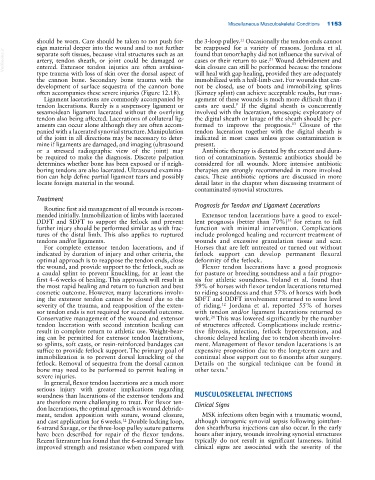Page 1187 - Adams and Stashak's Lameness in Horses, 7th Edition
P. 1187
Miscellaneous Musculoskeletal Conditions 1153
should be worn. Care should be taken to not push for the 3‐loop pulley. Occasionally the tendon ends cannot
11
eign material deeper into the wound and to not further be reapposed for a variety of reasons. Jordana et al.
VetBooks.ir artery, tendon sheath, or joint could be damaged or cases or their return to use. Wound debridement and
found that tenorrhaphy did not influence the survival of
separate soft tissues, because vital structures such as an
21
entered. Extensor tendon injuries are often avulsion‐
skin closure can still be performed because the tendons
type trauma with loss of skin over the dorsal aspect of will heal with gap healing, provided they are adequately
the cannon bone. Secondary bone trauma with the immobilized with a half‐limb cast. For wounds that can
development of surface sequestra of the cannon bone not be closed, use of boots and immobilizing splints
often accompanies these severe injuries (Figure 12.18). (Kimzey splint) can achieve acceptable results, but man
Ligament lacerations are commonly accompanied by agement of these wounds is much more difficult than if
tendon lacerations. Rarely is a suspensory ligament or casts are used. If the digital sheath is concurrently
9
sesamoidean ligament lacerated without the overlying involved with the laceration, tenoscopic exploratory of
tendon also being affected. Lacerations of collateral lig the digital sheath or lavage of the sheath should be per
aments can occur alone although they are often accom formed to improve the prognosis. Closure of the
13
panied with a lacerated synovial structure. Manipulation tendon laceration together with the digital sheath is
of the joint in all directions may be necessary to deter indicated in most cases unless gross contamination is
mine if ligaments are damaged, and imaging (ultrasound present.
or a stressed radiographic view of the joint) may Antibiotic therapy is dictated by the extent and dura
be required to make the diagnosis. Discrete palpation tion of contamination. Systemic antibiotics should be
determines whether bone has been exposed or if neigh considered for all wounds. More intensive antibiotic
boring tendons are also lacerated. Ultrasound examina therapies are strongly recommended in more involved
tion can help define partial ligament tears and possibly cases. These antibiotic options are discussed in more
locate foreign material in the wound. detail later in the chapter when discussing treatment of
contaminated synovial structures.
Treatment
Routine first aid management of all wounds is recom Prognosis for Tendon and Ligament Lacerations
mended initially. Immobilization of limbs with lacerated Extensor tendon lacerations have a good to excel
DDFT and SDFT to support the fetlock and prevent lent prognosis (better than 70%) for return to full
31
further injury should be performed similar as with frac function with minimal intervention. Complications
tures of the distal limb. This also applies to ruptured include prolonged healing and recurrent treatment of
tendons and/or ligaments. wounds and excessive granulation tissue and scar.
For complete extensor tendon lacerations, and if Horses that are left untreated or turned out without
indicated by duration of injury and other criteria, the fetlock support can develop permanent flexural
optimal approach is to reappose the tendon ends, close deformity of the fetlock.
the wound, and provide support to the fetlock, such as Flexor tendon lacerations have a good prognosis
a caudal splint to prevent knuckling, for at least the for pasture or breeding soundness and a fair progno
first 4–6 weeks of healing. This approach will result in sis for athletic soundness. Foland et al. found that
the most rapid healing and return to function and best 59% of horses with flexor tendon lacerations returned
cosmetic outcome. However, many lacerations involv to riding soundness and that 57% of horses with both
ing the extensor tendon cannot be closed due to the SDFT and DDFT involvement returned to some level
12
severity of the trauma, and reapposition of the exten of riding. Jordana et al. reported 55% of horses
sor tendon ends is not required for successful outcome. with tendon and/or ligament lacerations returned to
21
Conservative management of the wound and extensor work. This was lowered significantly by the number
tendon laceration with second intention healing can of structures affected. Complications include restric
result in complete return to athletic use. Weight‐bear tive fibrosis, infection, fetlock hyperextension, and
ing can be permitted for extensor tendon lacerations, chronic delayed healing due to tendon sheath involve
so splints, soft casts, or resin‐reinforced bandages can ment. Management of flexor tendon lacerations is an
suffice to provide fetlock support. The primary goal of expensive proposition due to the long‐term care and
immobilization is to prevent dorsal knuckling of the continual shoe support out to 6 months after surgery.
fetlock. Removal of sequestra from the dorsal cannon Details on the surgical technique can be found in
bone may need to be performed to permit healing in other texts. 9
severe injuries.
In general, flexor tendon lacerations are a much more
serious injury with greater implications regarding
soundness than lacerations of the extensor tendons and MUSCULOSKELETAL INFECTIONS
are therefore more challenging to treat. For flexor ten Clinical Signs
don lacerations, the optimal approach is wound debride
ment, tendon apposition with suture, wound closure, MSK infections often begin with a traumatic wound,
and cast application for 6 weeks. Double locking loop, although iatrogenic synovial sepsis following joint/ten
12
6‐strand Savage, or the three‐loop pulley suture patterns don sheath/bursa injections can also occur. In the early
have been described for repair of the flexor tendons. hours after injury, wounds involving synovial structures
Recent literature has found that the 6‐strand Savage has typically do not result in significant lameness. Initial
improved strength and resistance when compared with clinical signs are associated with the severity of the

